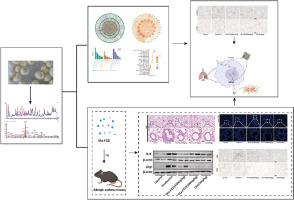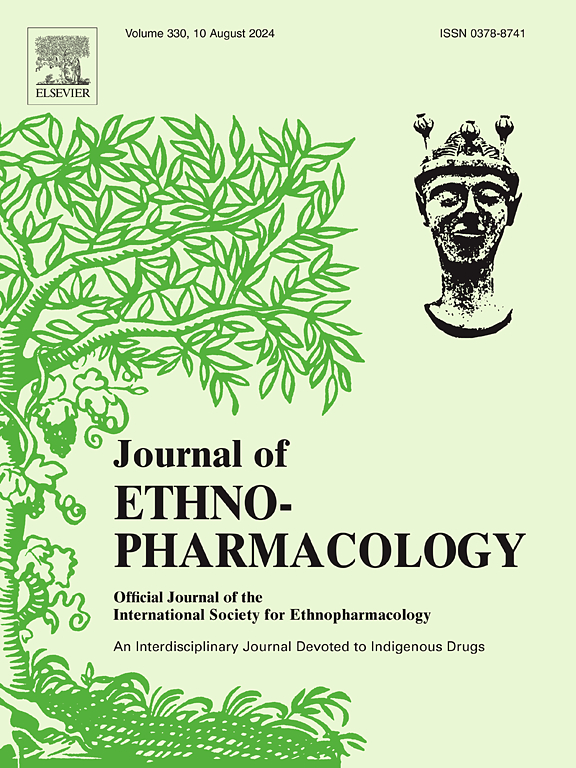通过抑制 M2 巨噬细胞极化缓解 OVA 诱导的过敏性哮喘
IF 4.8
2区 医学
Q1 CHEMISTRY, MEDICINAL
引用次数: 0
摘要
民族药理学意义Fritillaria cirrhosa D. Don(FCD)是一种用于治疗呼吸系统疾病的传统中药,具有清热、润肺、化痰、止咳的功效。此外,从 FCD 中提取的总生物碱可以缓解哮喘症状,减轻气道炎症。本研究探讨了 FCD 总生物碱(TAs-FCD)是否能减少 M2 巨噬细胞极化,从而减轻哮喘小鼠的气道重塑。该研究进一步阐明了其治疗过敏性哮喘的作用机制。材料与方法采用 UPLC-Q-TOF/MS 分析提取的 TAs-FCD 的成分。采用网络药理学方法确定了 TAs-FCD 的有效成分及其治疗过敏性哮喘的潜在机制。通过体内实验,建立、采用和验证了卵清蛋白诱发过敏性哮喘的小鼠模型。采用血红素-伊红染色法(H&E)、免疫组织化学法(IHC)、免疫荧光染色法(IF)、酶联免疫吸附法(ELISA)、免疫印迹法(WB)和实时荧光定量聚合酶链反应(q-PCR)研究TAs-FCD在过敏性哮喘中抑制M2巨噬细胞极化的作用。结果利用 SWISSADME 从 116 种化合物中筛选出了 66 种活性成分。通过 SwissTargetPrediction 预测了这 66 种化合物的靶点,在排除重复靶点后,得出了 808 个独特的药物靶点。此外,还从 DisGeNET、Genecard 和 OMIM 数据库中确定了 1756 个与过敏性哮喘有关的靶点。这使得活性成分靶点与过敏性哮喘靶点之间出现了 267 个交叉靶点,包括白细胞介素 (IL)-1β、肿瘤坏死因子 (TNF) 和 STAT3。动物实验表明,TAs-FCD 可改善小鼠肺部组织病理学损伤,减少气道周围胶原纤维积聚、气道粘液分泌和气道平滑肌增殖。TAs-FCD 还能降低肺组织中的 IL-1β、TNF-α 和 IL-4 水平,缓解气道炎症。此外,TAs-FCD 还能显著降低与 M2 巨噬细胞密切相关的 Arg1 和 CD206 的水平,并下调 p-STAT3 和 p-JAK2 的表达。本文章由计算机程序翻译,如有差异,请以英文原文为准。

Total alkaloids in Fritillaria cirrhosa D. Don alleviate OVA-induced allergic asthma by inhibiting M2 macrophage polarization
Ethnopharmacological relevance
Fritillaria cirrhosa D. Don (FCD) is a traditional Chinese medicine used to treat respiratory disorders, known for its effects in clearing heat, moistening the lungs, resolving phlegm, and relieving cough. Additionally, the total alkaloids extracted from FCD can alleviate asthma symptoms and reduce airway inflammation. However, no studies have investigated the effects of total alkaloids on lung macrophages.
Aim of the study
This study explored whether the total alkaloids of FCD (TAs-FCD) reduce M2 macrophage polarization and, consequently, attenuate airway remodeling in asthmatic mice. This study further elucidated its mechanism of action in treating allergic asthma.
Materials and methods
The extracted TAs-FCD was analyzed for its composition using UPLC-Q-TOF/MS. Network pharmacology was employed to identify the active ingredients and potential mechanisms of TAs-FCD in the treatment of allergic asthma. A mouse model of ovalbumin-induced allergic asthma was established, adopted, and validated through in vivo experiments. Hematoxylin-eosin staining (H&E), immunohistochemistry (IHC), immunofluorescence staining (IF), enzyme-linked immunosorbent assay (ELISA), Western blotting (WB), and real-time fluorescence quantitative polymerase chain reaction (q-PCR) were used to investigate the role of TAs-FCD in inhibiting M2 macrophage polarization in the context of allergic asthma.
Results
A total of 66 active ingredients were screened from 116 compounds using SWISSADME. The targets of these 66 compounds were predicted by SwissTargetPrediction, resulting in 808 unique drug targets after excluding duplicates. Additionally, 1756 targets related to allergic asthma were identified from the DisGeNET, Genecard, and OMIM databases. This led to 267 cross-targets between the active ingredient targets and allergic asthma targets, including interleukin (IL)-1β, tumor necrosis factor (TNF), and STAT3. Animal experiments demonstrated that TAs-FCD improved histopathological injury in mouse lungs, reduced peri-airway collagen fiber accumulation, airway mucus secretion, and airway smooth muscle proliferation. TAs-FCD also lowered IL-1β, TNF-α and IL-4 levels in lung tissues and alleviated airway inflammation. Furthermore, TAs-FCD significantly reduced levels of Arg1 and CD206, which are closely associated with M2 macrophages, and downregulated the expression of p-STAT3 and p-JAK2.
Conclusion
TAs-FCD may inhibit M2 macrophage polarization by regulating the JAK2/STAT3 pathway, thereby alleviating airway remodeling and inflammation in allergic asthmatic mice.
求助全文
通过发布文献求助,成功后即可免费获取论文全文。
去求助
来源期刊

Journal of ethnopharmacology
医学-全科医学与补充医学
CiteScore
10.30
自引率
5.60%
发文量
967
审稿时长
77 days
期刊介绍:
The Journal of Ethnopharmacology is dedicated to the exchange of information and understandings about people''s use of plants, fungi, animals, microorganisms and minerals and their biological and pharmacological effects based on the principles established through international conventions. Early people confronted with illness and disease, discovered a wealth of useful therapeutic agents in the plant and animal kingdoms. The empirical knowledge of these medicinal substances and their toxic potential was passed on by oral tradition and sometimes recorded in herbals and other texts on materia medica. Many valuable drugs of today (e.g., atropine, ephedrine, tubocurarine, digoxin, reserpine) came into use through the study of indigenous remedies. Chemists continue to use plant-derived drugs (e.g., morphine, taxol, physostigmine, quinidine, emetine) as prototypes in their attempts to develop more effective and less toxic medicinals.
 求助内容:
求助内容: 应助结果提醒方式:
应助结果提醒方式:


